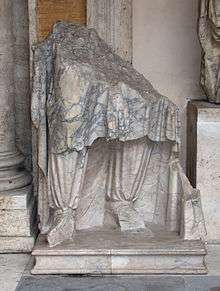Pavonazzo marble
Pavonazzetto marble also known as Docimaean marble or Synnadic marble,[1] is a white marble originally from Docimium, or modern İscehisar, Turkey. [2][3]

The name derives from the Italian word for peacock (pavone). "In natural stone trade, Pavonazzo is often simply called a Marble."[4] It is one of the many varieties of Carrara marble, distinguished by black/gray-veined white marble.[5] Also referred to as "pavonazzetto", and distinguished as:
- Various red and purplish marbles and breccias.
- A marble, used by the ancient Romans, characterized by very irregular veins of dark red with bluish and yellowish tints.[6]
The marble has been used in Rome since the Augustan age, when large-scale quarrying began at Docimium, and columns of it were used in the House of Augustus, as well as in the Temple of Mars Ultor, which also had pavonazzo floor tiles in the cella. Pavonazzetto statues of kneeling Phrygian barbarians existed in the Basilica Aemilia and Horti Sallustiani. Giant statue groups carved from Docimaean marble were discovered at Tiberius's Villa in Sperlonga. Pavonazzetto was not widely or extensively used before the Roman period; there is no evidence of it in circulation before the last two decades B.C.[7] Later it was used in Rome in Trajan's Markets and for the Memoria Petri, the tomb of Saint Peter and internationally in the influential Baroque Revival style historic buildings the Church of St. Ignatius Loyola, in New York City, and Belfast City Hall in Belfast, Northern Ireland.
See also
References
| Wikimedia Commons has media related to Pavonazzo marble sculptures. |
- Strabo. Geography. "Book 9, chapter 5, section 16"
- Erica Highes (2013). Meaning and λόγος: Proceedings from the Early Professional Interdisciplinary. University of Liverpool. p. 29.
- Elise A. Friedland (2015). The Oxford Handbook of Roman Sculpture. p. 181.
- "Pavonazzo - a white Marble from Italy". Graniteland.com. 2012-09-11. Retrieved 2012-12-20.
- "Stone Info | Granite Marble". Es.pavonazzo.italy.marble.stoneinfo.us. Archived from the original on 2012-03-03. Retrieved 2012-12-20.
- "pavonazzo, pavonazzeto: Information from". Answers.com. Retrieved 2012-12-20.
- Matthias Bruno, et al. “The Docimium Marble Sculptures of the Grotto of Tiberius at Sperlonga.” American Journal of Archaeology, vol. 119, no. 3, 2015, pp. 375–394.